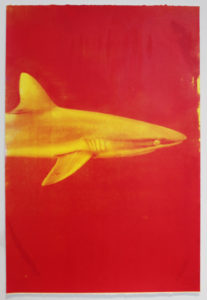By Marty Fugate
Exhibit Review, Jusly 2016
“Editions” celebrates the power of the print through July 15 at Alfstad Contemporary. This greatest hits sampling of the gallery’s first three years features pieces by Betsy Cameron, Alain Huin, Marsha Kazarinov-Owett, Andrea Dasha Reich, Mike Solomon, Bruna Stude, Michael Taylor and Michael Wyshock. Thanks to state-of-the-art, print-making technology, their work comes to crystal clear life. The images are good. Almost too good …
Mike Solomon’s “Sea of Grandeur” looks simple and straightforward at first. A fishing net with a field of blue behind it, that’s all. Look deeper, and you’ll see that “blue” is just a convenient term. Inside that net, there are really countless shades and infinite variety. Solomon’s subtle image evokes philosopher Alan Watts’ meditations on consciousness. “The world is wiggly,” Watts said. “The rational mind can’t take it all in, so we impose a Cartesian grid on the wiggles. It’s a very useful tool, so long as we don’t take it too seriously. We see the world through the net. But the net doesn’t really contain the world.”

Bruna Stude’s “Predator/Prey #2” is a manipulated silkscreen print derived from one of Stude’s underwater photographs — part of her series protesting humanity’s slaughter of the ocean’s apex predator in pursuit of shark fin soup. She’s colorized the image in Wharhol-esque shades of yellow and red. It’s a glamor shot –and a subtle reminder of the sheer otherness of the species. This image is pretty — but you know that’s thanks to the artist’s skill. Sharks aren’t reallypretty to our mammalian eyes. They’re outside human categories — all the more reason not to wipe them out.
Speaking of pretty, Betsy Cameron’s “Poppy” is nice to look at — and a slap in the face of sentimentalists everywhere. PapaverSomniferum. Just an ordinary flower — and unlike any flower you’ve ever seen. Cameron’s camera captures the subtle structure of the thing with a naturalist’s precision. Her up-close framing strips away context and sense of scale; her high-speed film records more detail and clarity than the naked eye can see. The result is a defiantly alien beauty. This flower is a “floral” in name only.
That’s just a sample of the powerful art you’ll see here — images beautiful, tactile, weird, highly personal, fiercely objective, and occasionally disturbing. To make it even more disturbing, these images aren’t first-generation photographs, drawings, paintings or assemblages. They’re prints, although you’d never know it at a casual glance. What’s going on?
On a technical level, it’s easy to explain.
Chris Schumaker scanned in the original art at insanely high resolution, then generated large-scale prints on everything from paper to canvas to aluminum. Some pieces are screen-printed; others are continuous tone, giclée output. The images are so good, you have to wonder: Is it fine art on the walls, or high-tech reproductions? Good question. But maybe the wrong one.
Printmaking is inherently disruptive technology — especially in the visual art world. The humble print destroys the notion of the precious, one-of-a-kind “original” art object; makes the one-time status symbols of kings and popes affordable; eludes censorship; and forces cranky, individualistic artists to be team players. It’s always been that way. The 21st century print technology on display here only takes it up a notch. The real question is …
What are they going to do next?
Originally printed in the Sarasota Herald-Tribune.